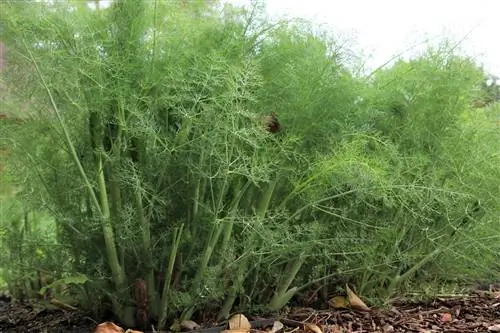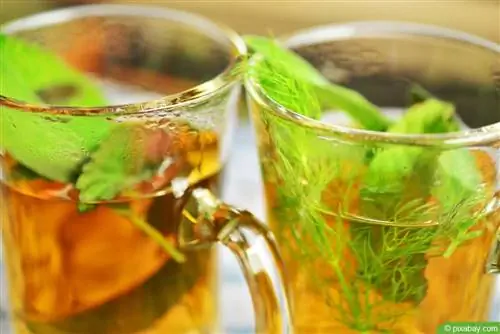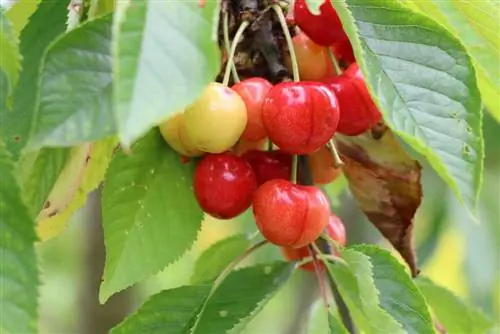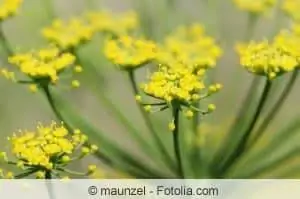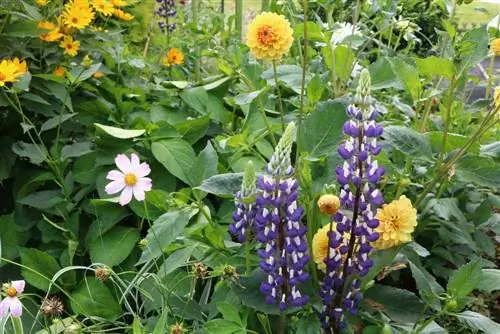- Author admin [email protected].
- Public 2023-12-17 03:39.
- Last modified 2025-06-01 06:48.
The Foeniculum vulgare or simply fennel is a plant that can be found in three different versions as a vegetable, as a spice plant or sweet fennel or as a wild plant, also known as bitter fennel. What all species have in common is that they can be used - both in the kitchen and in medicine.
Sowing
The propagation of Foeniculum vulgare is very easy and can be implemented even by inexperienced hobby gardeners. The plant is propagated by its seeds. From February onwards the seeds can be grown in flower pots. All that is important for pre-breeding is a warm location in the house. From May onwards, the small plants can be released outdoors. If you want it to be even more convenient, sow the Foeniculum vulgare outdoors straight from May.
Location
The Foeniculum vulgare is a biennial plant. However, if you purchase the plant once, you won't have any problems having a long-term supply of this plant in the garden, because it grows very well. When grown outdoors, the Foeniculum vulgare particularly appreciates humus- and nutrient-rich soils in order to thrive particularly well. The Foeniculum vulgare also has no problems with continuous sunlight, as it particularly appreciates sunny locations and is often found in these locations in nature. This plant also easily tolerates full sun places that are less conducive to other plants. A normal garden soil is suitable as a substrate, but it should be well-drained and not waterlogged. If the soil is not permeable enough, it can be mixed with normal sand for the plant. The ideal location offers
- lots of sunlight
- humus and nutrient-rich soil
- a permeable substrate in which waterlogging does not form
Plants
Planting Foeniculum vulgare is very simple and completely uncomplicated. The Foeniculum vulgare is an old and very original plant with a Mediterranean background, which also thrives in our latitudes. In Central Europe the plant can also be found in a wild form. To be able to plant Foeniculum vulgare, all you need is a location with lots of sunlight. To do this, the plant should be planted in moderately dry but nutrient-rich soil after the seeds have been pulled. In order to achieve particularly good growth, a base-rich clay or loess soil is ideal. This is why overgrown weed communities, vineyard edges or semi-ruderal lean grasslands are particularly often colonized by overgrown Foeniculum vulgare. The harvest of Foeniculum vulgare can then take place between June and September. If the plant is to be planted in a herb garden, it is important to know that it belongs to the dill family. It is therefore important not to plant these two plants too close together, because cross-pollination causes both plants to lose their typical anise-like aroma.
Cut
The fennel can be cut back to the height of a hand after flowering or in very early spring before budding begins, i.e. from the beginning of February to March. A good and regular cut strengthens the plant and produces larger fruits for the vegetable plant. The cut should be made at an angle so that rainwater can easily drip off the cut. This means that the plant is protected from waterlogging and therefore fungal attack, even at the cut.
Tip:
The simple rule is that when cutting the Foeniculum vulgare you cut as deeply as possible, but never cut deeper than a maximum of 1 1/2 cm above the last fresh shoot.
Pouring
The Foeniculum vulgare is a plant that requires adequate water supply. However, the plant doesn't mind occasional periods of slight drought because it is very robust overall. If the plant is watered, you should definitely make sure that the Foeniculum vulgare is not standing in backwater, because the fennel doesn't appreciate that at all. If you pay attention to permeable soil when planting, then Foeniculum vulgare is also very easy to water. By the way, it is also completely unproblematic to water the plant from above and thus wet the flower itself. Sufficient water supply and mulching with straw help prevent drying out and so-called bolting of the plant in summer, even at very high temperatures, and this also promotes the development of particularly large plants.
Fertilize
Fertilizing Foeniculum vulgare should begin before planting. Applying some horn meal and compost is an ideal basis for the Foeniculum vulgare to thrive. Basically, the Foeniculum vulgare has a moderate nutrient requirement. The optimal location for Foeniculum vulgare is in the second row in front of the previous crops mentioned, which receive organic fertilization. Here the Foeniculum vulgare gets the perfect amount of fertilizer.
Diseases/Pests
If you find honeydew, galls or curled leaves on the Foeniculum vulgare, then an infestation by aphids is very likely. An insecticide is helpful, but this can only be used if the plant is used exclusively for decorative purposes. The biological treatment of the plant, which is also used in the kitchen, should be carried out using parasitic wasps or predatory mosquitoes. If the plant suddenly shows signs of wilting or even pale green discoloration, then a fungal infection is very likely. This is usually caused by waterlogging, to which this plant is very sensitive. Infected plants should be removed immediately so that they do not infect other plants with the fungus. To avoid fungal infestation, it is important to avoid waterlogging and over-fertilization.
If traces of feeding or mucus are found, a snail infestation is very likely. Regular tillage and good but moderate watering stabilize the plant. The snails themselves should be collected from the plant in the evening hours. Under no circumstances should special pesticides be used against the snails, as these no longer make it possible to use the plant in the kitchen. An infestation of snails and aphids can be prevented by planting correctly, namely by growing the seeds instead of sowing them directly outdoors. This cultivation also produces higher quality harvests. The most common pests/diseases of fennel are
- Aphid infestation
- Fungal infestation
- Snail infestation
Wintering
From October onwards, the bed with the fennel should be covered to protect against frost or the tubers should be piled up.
Frequently asked questions
How can I use Foeniculum vulgare as a medicinal plant?
The fennel flowers can be used to make teas that are helpful for the gastrointestinal tract and reduce flatulence, for example. The tea can also be used as a natural, cough-relieving remedy.
Why is fennel so he althy as a vegetable?
The Foeniculum vulgare has a lot of essential oils. Fennel also contains silica as well as mineral s alts and starch, as well as vitamins A, B and C. The vitamin C content of fresh fennel is 247.3 mg per 100 g fresh weight.
What you should know about fennel in brief
Care
- The young plants need a lot of space, you should not plant more than around 10 plants per square meter.
- The nutrient-hungry young plants are placed in compost-enriched soil.
- You should be pampered with nettle manure as a liquid fertilizer once or twice per season.
- The soil should be well calcareous and kept moist.
- You can cover the fennel outside for the first month if you are in a colder area; it will absorb more heat under fleece.
- Fennel usually grows very well if you plant it as a follow-on crop to peas or potatoes.
- Fennel is at least two years old and in the first year only shows a rosette of leaves, which is used for the development of the tuber.
- It is only in the following year that the sprout develops. When it sprouts again in the second year, you can then start harvesting.
Usage
- You can harvest multiple times, starting with the first leaves.
- The leaves, especially the fine herb at the top, can be cut again and again until autumn.
- If you want to harvest fennel seeds, you need more patience: the seeds in the cones are ready to harvest around the end of September.
- The fennel bulbs come last, they are piled up a little in autumn, depending on the time of planting they can be harvested between the beginning of October and the beginning of December.
- If there is already a risk of frost, you should protect the fennel against the cold with a thin layer of leaves (but it can withstand light night frost).
- Fennel freezes well, both the bulbs (cleaned, diced and blanched) and the leaves (finely chopped, possibly with a little water in the ice cube tray).
Healing effects?
- For coughs, for example, fennel tea with honey is a helpful remedy, but you can also use fennel for headaches and stomach aches.
- Babies are given fennel tea for stomach pain and flatulence. Attention: Here it is better to use children's fennel tea from the shops!
The garden fennel is sold in different varieties that are particularly suitable as a vegetable (fleshy leaves) or are intended to be used as a spice or for medicinal purposes.

